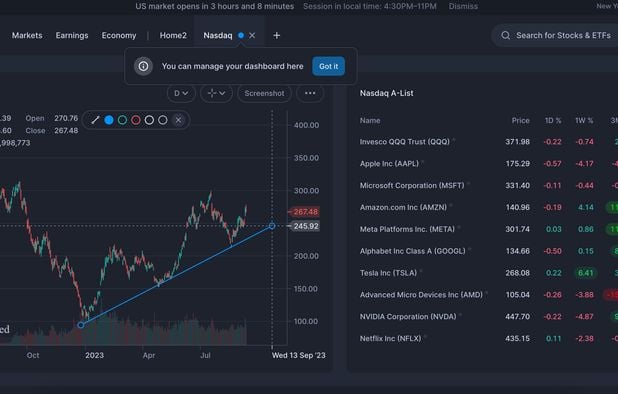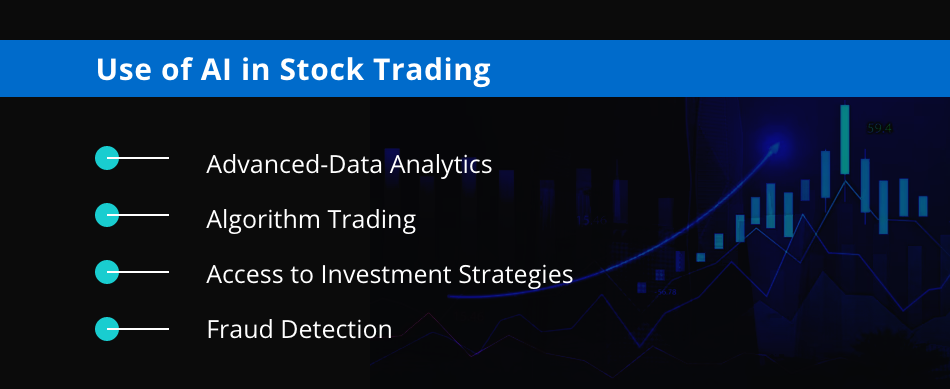20 Free Reasons For Selecting AI Stock Picker Analysis Websites
20 Free Reasons For Selecting AI Stock Picker Analysis Websites
Blog Article
Top 10 Tips On Pricing And Costing Of Ai Stock Predicting Trading Platforms
Pricing and cost of AI-based stock forecasting and analyzing trade platforms is crucial to avoid unanticipated costs or hidden fees. Prices can be very different, so it's important to be aware of what you're getting value for your money. Here are the top ten suggestions for evaluating cost and price:
1. Find out more about the pricing model
Subscription-based platforms: Find out the cost of a monthly or yearly cost. Also, learn what features come with each level.
Pay-per-use : Confirm that the platform charges you according to the amount of usage (e.g. requests for trades, for information, or forecasts).
Freemium Model: Check to see if the platform offers a free version which offers the most basic features. The premium features are paid for.
2. Compare Pricing Tiers
Check out the features included in each price tier.
Scalability: Ensure that the pricing tiers you choose are in line to your requirements.
Upgrade flexibility - Check to see if there are options to easily upgrade or downgrade it as your needs may be changing.
3. Evaluate Hidden Costs
Data fees: Check if there are any extra charges for premium data (e.g. live data, or advanced analytics).
Brokerage fees - Make sure to find out if additional fees are charged by the platform to trade execution or integration with brokers.
API usage: Determine whether the cost of API access is higher or if the API usage is very frequent.
4. Test out free demos and trial versions
Trial period: Choose platforms that let you test out the features of their platform prior to making an investment.
The trial's limitations: Verify if it includes all features, or if there are limitations regarding the functionality.
Optional with no commitment The user should be able to cancel your trial without incurring fees if you feel that the platform does not meet your needs.
5. Look for promotions and discounts.
Annual discounts: See whether you qualify for an annual discount plan, compared to the monthly.
Referral programs - See whether there are any discount or credits available for referring new users.
Bulk or Institutional Pricing If your company is a large one it is possible to ask about bulk and institutional pricing.
6. Examine the Return on the investment
Cost in relation to. value: Determine if the features and forecasts of the platform justifies the cost. For example, does it aid you in making better trade decisions or help you save time?
Study the platform's success rates or user testimonials to assess its potential return on investment.
Costs of alternative platforms: Compare the cost of the platform against the possible cost of not using it (e.g. not utilizing opportunities, time spent on manual analysis).
Review Cancellation Policies
You are able to end your subscription at any time without paying any fees or penalties.
Make sure to check if there's a refund policy for subscriptions you've not used.
Auto-renewal Check to find out whether your subscription renews automatically and also learn how to opt out.
8. Examine Pricing Transparency
Price page that is clear: Make sure the platform has a detailed and up-to-date pricing page that is free of hidden charges.
Customer Support If you have any questions about prices and costs, contact customer service.
Contract Terms: Know the long-term obligations and penalties by studying the contract's terms.
9. Compare your competitors
Comparing the features and costs of different platforms against their rivals can help you find the best deal.
User reviews: Read reviews from users to determine if others feel that the platform is worth the investment.
Market positioning: Check whether it is priced as premium, mid-tier or a budget choice and if it aligns with your expectations.
10. Estimate the Long-Term cost
Price increases: Determine if there is a pattern of price increases and the frequency at which they occur. often they occur.
Additions of features: Check whether your current plan contains new features or needs an upgrade.
Scalability costs: Make sure the price of the platform is affordable when you expand the volume of data or trading you require.
Bonus Tips:
Free trials for multiple platforms are available for you to try and evaluate the benefits and performance of various platforms.
Negotiate price: If your institution is frequent user, you should consider to inquire about discounts or customized pricing.
You can find free educational sources on certain platforms.
If you follow these guidelines, you can effectively assess the cost and pricing of AI platform for predicting and analyzing stocks and ensure you select one that fits your budget and delivers the features and performance you need. The price of a good platform must be able to combine the affordability of the platform with its performance. This will enable you to get the most out of your trading. Follow the top rated ai stock market url for more tips including ai trading tools, best ai trading software, incite, ai stock trading bot free, stock ai, market ai, ai stock trading bot free, trading with ai, best ai for trading, ai trade and more.
Top 10 Ways To Evaluate The Regulatory Compliance Of Ai Stock Analysis And Prediction Platform
The regulatory compliance of trading platforms using AI to forecast or analyze price movements is a crucial aspect. Compliance is essential as it guarantees that the platform complies with regulations and legal frameworks. Also, it protects user's data. Here are 10 strategies to determine the regulatory compliance of these platforms.
1. Verify Registration and License
Authorities regulating the platform: Make sure that the platform's registration and license is with the relevant financial regulators (e.g. SEC or FCA in the United States, ASIC or ASIC in Australia).
Check that the brokers included in the platform are licensed and licensed and.
Public records: Go to the site of the regulator to see whether the platform was licensed or if it's ever violated the law.
2. Compliance with the Data Privacy Evaluation
GDPR: Make sure that your website adheres to the General Data Protection Regulation.
CCPA for users living in California, verify conformity to the California Consumer Privacy Act (CCPA).
Data handling policies. Review the platform’s privacy policy and make sure it clearly outlines how data about users is collected, shared, and kept.
3. Examining anti-money laundering measures
AML policies: Make sure that your platform is equipped with a solid AML policy to identify and stop any laundering of money.
KYC procedures. See whether your platform is following Know Your Customer processes for verifying user identity.
Monitoring transactions: Ensure that the platform is monitoring transactions in order to identify suspicious activity and notify authorities.
4. Verify your compliance with Trading Regulations
Market manipulation: Make sure that the platform is equipped with measures to protect against market manipulation like spoofing or wash trading.
Order types. Check that the platform complies with all rules regarding order type (e.g. there isn't any stop loss hunting that is illegal).
Best execution: Verify that the platform adheres to best execution practices to ensure that trades are executed at the highest price.
5. Cybersecurity Assessment
Data encryption: Make sure that the platform is secure for the user's data while it is during its travel and also when it's in storage by encrypting it.
Incident response. Verify that there is a clearly defined incident response plan for the platform to address cyber attacks as well as data breaches.
Certifications - Check to see whether your platform is certified. cybersecurity certifications.
6. Transparency Evaluation and Disclosure
Fee disclosure: Make sure that the platform has clearly disclosed all fees, hidden charges or additional costs.
Risk disclosure: Verify whether the platform includes explicit risk disclosures. Particularly, for high-risk or leveraged trading strategies.
Performance reporting: Ensure that the AI platform is transparent and provides exact performance information for its AI model.
7. Make sure that you are in compliance with International Regulations
Transparency in trading across borders If you're trading internationally, make sure that the platform you use is in compliance to all laws and regulations.
Tax reporting - Check the platform's tools and reports to help users to comply with tax laws.
Sanctions compliance: Ensure that the platform adheres to international sanctions and doesn't allow trading only to nations or entities banned.
8. Assess Record-Keeping and Audit Trails
Records of transactions: The platform must keep detailed records of every transaction that is used for regulatory and auditor purposes.
User activity logs (logs): Check to determine if the platform is tracking the activities of users, such as transactions and logins. Also, verify if account settings are modified.
Check for audit readiness: Determine whether your platform is able to provide the required documentation and logs in the case of an inspection from a regulatory authority.
9. Examine the compliance of AI Specific Regulations
Algorithmic Trading Rules: If your platform supports trading using algorithms, ensure that it is compliant with the rules such as MiFID II (in Europe) or Reg SCI (in the U.S.).
Bias and fairness: Verify whether the platform monitors and reduces biases in its AI models to ensure fair and ethical trading.
Explainability - Make sure that the AI platform can clearly and concisely explain about AI-driven predictions, decisions and more. as required by certain regulations.
Review User Feedback & Regulatory History
User reviews: Research user feedback to gauge the reputation of the platform's regulator conformity.
Examine the regulatory history to see if there were penalties or fines for violations of regulations.
Third-party audits: Verify if the platform undergoes regular third-party audits to ensure compliance with regulations.
Bonus Tips
Consultations with a lawyer: You may consider consulting a lawyer in order to determine if the platform is compliant with relevant regulations.
Trial period. Use the free trial or demo version of the platform to try out its compliance features.
Customer support: Check that the platform can provide assistance to customers who have questions or concerns related to compliance.
Follow these tips to evaluate the regulatory compliance and security of your rights. It is essential to be in compliance since it not only reduces legal risks, it also increases trust and confidence for the platform. Check out the best invest ai url for website examples including ai in stock market, ai for trading stocks, ai tools for trading, ai for trading stocks, best ai for stock trading, ai stock predictions, ai stock investing, free ai tool for stock market india, trading ai tool, ai stock analysis and more.